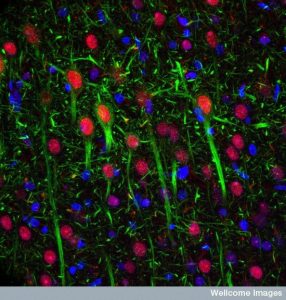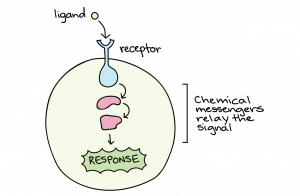23 Cell Signaling
Andrea Bierema
Learning Objectives
Students will be able to:
- Describe how ligands and receptors are involved in cell signaling.
- Describe the different types of cell signaling.
- Explain how neurons (nerve cells) communicate with each other.
- Identify how drugs influence dopamine signaling.
Cell Signaling Overview

Cells “communicate” with each other via signaling. That is, one cell either directly connects or- more often- sends signaling molecules (which are often proteins) to another cell (or sometimes even back to itself), which triggers a response. Cell signaling influences a variety of cell functions, including the synthesis of specific proteins and cell division.
Not all cells can “catch” a particular signal. In order to detect the signal, the cell must have the right receptor for that signal. When a signaling molecule binds to its receptor, it alters the shape or activity of the receptor, triggering a change inside of the cell. Signaling molecules are often called ligands, a general term for molecules that bind specifically to other molecules (such as receptors).


Exercise
See the entire image that this exercise was based on.
Forms of Signaling
There are different ways in which one cell sends another cell a signal. The video below summarizes these types of signals.
Exercise
Complete this mini-quiz on the main types of cell signaling after watching the video above.
Neuron Communication
One unique example of cell signaling is synaptic signaling, in which a nerve cell (called a “neuron”) transmits a signal to another neuron. This process is named for the synapse, the junction between two nerve cells where signal transmission occurs.
When the sending neuron fires, an electrical impulse moves rapidly through the cell, traveling down a long, fiber-like extension called an axon. When the impulse reaches the synapse, it triggers the release of neurotransmitters, which quickly cross the small gap between the neurons. When the neurotransmitters arrive at the receiving cell, they bind to receptors and cause a chemical change inside of the cell (often, opening ion channels and changing the electrical potential across the membrane. The video below illustrates this process.
Exercises
Neurons and Drug Use
One neurotransmitter commonly discussed is dopamine. This molecule is naturally produced in the body and its release of causes “feel good” sensations. Drugs can change the dopamine pathway, such as preventing it from releasing from the receptors.
To learn how different drugs impact this pathway, see the animated infographic below (press play to see the animations).
Press play on the above infographic to view animations of cell signaling. This animated infographic was produced by American Addiction Centers. Learn more about the project and find an accessible version on their page.
Hormones and the Endocrine System
Cell signalling is key in how hormones function. Learn more about hormones and the endocrine system in this TEDEd animation.
Attribution
This chapter is a modified derivative of “Introduction to Cell Signaling.” by Khan Academy, CC BY-NC-SA 4.0. Download the original article for free at https://www.khanacademy.org/science/biology/cell-signaling/mechanisms-of-cell-signaling/a/introduction-to-cell-signaling

